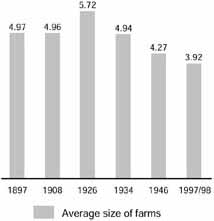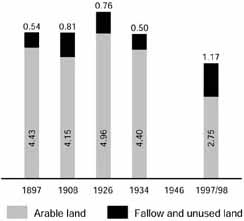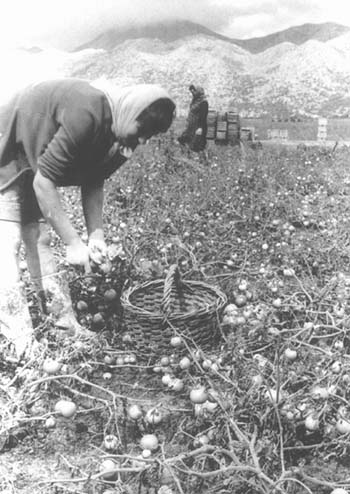F. Rembold
Fritz Rembold is Land Tenure and Rural Development
Officer at the FAO Subregional Office for Central and Eastern Europe, Budapest.
After 50 years of collectivization, countries in Central and Eastern Europe (CEE) and the Commonwealth of Independent States (CIS) have made significant progress in the devolution of state-owned real estate to private urban and rural ownership. Despite the remarkable success of the land-reform process, land fragmentation has emerged as a side-effect, with detrimental implications for private and public investments, sustainable economic growth and social development. Less-favoured and least-developed regions with economies still dependent on agriculture have experienced negative growth rates, soaring unemployment and mounting rural poverty, resulting in serious social and economic disintegration and widespread disappointment among local actors and stakeholders.
This article presents the results and findings of an FAO-commissioned comparative study on the impact of land fragmentation on rural society in four countries: Bulgaria, the Czech Republic, Hungary and Romania. It highlights the conditions necessary to address the issue of land fragmentation and outlines the strategies, goals and objectives of proposed land-consolidation processes. The article emphasizes that land consolidation is not a single, isolated issue: it goes beyond land administration systems and concerns areas other than agriculture. The solution to land fragmentation could well be the starting point for achieving food security and sustainable rural livelihoods because it will involve an integrated package of measures, including territorial organization, land management, farming systems and management, regional development and village improvements. In order to be as comprehensive as possible, it will be necessary to secure the active participation of as wide a range of stakeholders as possible, especially at the local and regional levels.
INTRODUCTION
FAO has commissioned comparative studies on the impact of land fragmentation on rural society in four European Union (EU) candidate countries: Bulgaria, the Czech Republic, Hungary and Romania. Feasibility studies on strategies for improved land management and land consolidation were also elaborated for Armenia and Georgia. The findings of these studies highlight the necessary conditions and requisites to address the issue and describe strategies, goals and objectives of proposed land consolidation processes.
BACKGROUND
During the past decade, countries in Central and Eastern Europe (CEE) and the Commonwealth of Independent States (CIS) have made signifi cant progress concerning the devolution of state-held real estate and property, both urban and rural, to private owners. Considered to be a cornerstone in the economic transition process, this process of “reprivatization” has been accelerated so as to secure land tenure and property rights and to develop land markets. However, in spite of the remarkable success of the land reform process, land fragmentation emerged as a side effect with detrimental implications for private and public investments, sustainable economic growth and social development. Less-favoured and least-developed regions with economies that still depend on agriculture have been witnessing negative growth rates, soaring unemployment, mounting rural poverty and, as a result, serious socio-economic disintegration and widespread disappointment among local actors and stakeholders.
Land fragmentation primarily affects the agriculture sector. When cooperative and state farmlands were distributed according to equity principles, without first taking farm management aspects into consideration, the result was that the parcels which farmers received were either too small or were badly shaped, for instance in length-to-width ratio. In some countries, farm size averages 0.5 to 2.5 ha, which has made it difficult to implement new production patterns or to utilize machinery and appropriate technologies. Re-allotment and amalgamation of plots (and parcels) is an important step to increase both productivity and efficiency in the agriculture sector. Most private farmers are restricted to subsistence agriculture and cannot participate in commercial production, which leads to migration and the abandonment of farmland, especially in areas far from markets. In the Czech Republic, for instance, privately owned agricultural land is still to some extent incorporated into large user units (a heritage from the era of collective management) which prevent private landowners from using their own land for farming. At the same time, the situation is inhibiting land market development, investment in land and completion of the restitution process.
Land consolidation is not, however, an issue that stands alone: it goes beyond land administration systems and includes questions besides agriculture. It could well be the starting point for both food security and sustainable rural livelihoods. It integrates measures regarding territorial organization, land management, farming systems and management, regional development and village renewal in order to be as comprehensive as possible, and therefore ensure the active participation of a wide range of stakeholders, especially at local and regional levels.
The facts and figures from two of the studied countries, Bulgaria and Romania, are given as examples.
Bulgaria[12]
Farmland in Bulgaria totals 6.2 million ha. Arable land represents 77 percent of this total, and pastures and meadows 23 percent. By the end of 1999, over 94 percent of farmland had been restored to private owners. About 96 percent of all land in Bulgaria is private farmland, including cooperatives; the remaining 4 percent is state or municipal farms. Meadows and pastures in private hands total 29 percent, of which 33 percent are owned by cooperative farms. About 71 percent of meadows are under public (state and municipal) domain. After finalizing the land reform, an estimated 2.6 million private titles will be issued, and over 12 million plots averaging 0.4 to 0.5 ha will be created. The average agriculture holding size will be approximately 2 ha, composed of four to five parcels.
After completion of the land reform, a further reduction in average holding size by a factor of 1.6 to 1.7 within the first three years can be expected, which will aggravate the situation. The reason is the ongoing subdivision of land among heirs of titleholders. Subdivisions are currently the most frequent farmland transactions, and extrapolated data indicate that average plot size may fall to less than 0.3 ha, the legal minimum for agriculture use (the minimum for orchards is 0.2 ha and for vineyards, 0.1 ha).
The number of individual farms has fluctuated between 1.7 and 2 million over the past seven years. Farms of less than 1 ha in area comprise 85 percent of all individual farms and 26 percent of agricultural land. The farmers in this group produce mainly for subsistence and are commonly engaged in part-time farming. The second cohort, with 13 percent of farmers, holds 26 percent of farm land, with farms sizes ranging in size from 1 to 5 ha. These farms are considered to be marginal, providing only subsistence with little market participation. The third group, less than 1 percent, consists of farms ranging in size from 5 to 10 ha and occupies only 7 percent of the private farm area. The smallest group of farmers, representing only 0.2 percent, owns more than 10 ha each and cultivates more than 41 percent of agricultural land, although predominantly via leasehold agreements. To sum up, over 98 percent of the farmers cultivate 52 percent of the land and own estates of 5 ha or less. As shown in Figure 1, the average farm size in 1998 was 3.92 ha; farms had not been this small for 100 years. It is to be noted, in this context, that almost 30 percent of land is fallow, unused or abandoned, which can be interpreted as another indicator of inappropriate land-use planning and land management.
Romania[13]
In Romania, the total agricultural area comprises 14 791 000 ha, representing 63 percent of the country's total territory. During the land reform, approximately 9 400 000 ha of collectivized land, state-owned property and cooperatives were restored to private owners. Some 1 300 000 ha in mountainous areas are privately owned, and the remaining share of approximately 4 091 000 ha belongs to the state or to commercial companies.
On the basis of the 1991 Land Law, 4 709 108 natural and legal persons claimed an area comprising over 9.4 million ha. As outlined in Table 1, in 2000 the title process was not yet complete. By the end of 1999, some 3.8 million claims for individual farms had been recognized, and approximately 3.3 million land titles had been issued for farms, totalling some 8 million ha. The average farm size is thus about 2.28 ha, with a range from 1.3 to 4.1 ha. Individuals hold 4 to 5 parcels, each approximately 3 000 m2 in size. Especially in the plains region, the former cooperatives were divided into rectangular pieces with parcels as narrow as 3 m and up to 1 km long. As for the ownership structure outlined in Table 2, in 1998, 69 percent of farmers possessed less than 2 ha each. From 1993 to 1999, the size per family holding increased only marginally, from 2.1 to 2.28 ha (see Table 3). Some 57 percent of the owners are older than 65, and 43 percent are absentees living elsewhere in the country or abroad.
Figure 1
Evolution of average farm size and land use in Bulgaria, 1897–1998
A: Average farm size (ha)

B: Land use (ha)

TABLE 1
Land registration and titling
| |
Indicators |
Percentage of total |
|
Total area to be privatized (ha) |
9 405 776 |
100 |
|
Total area adjudicated (ha) |
8 043 818 |
85.5 |
|
Total number of claimants |
4 709 108 |
100 |
|
Total number of registered properties |
3 879 563 |
82.4 |
|
Total number of ownership titles issued |
3 383 063 |
78.1 |
Source: Ministry of Agriculture and Food, Romania. Buletinul informativ, No. 3/2000.
TABLE 2
Ownership structure
|
Household size |
1948 |
1998 |
|
(Percentage) |
||
|
Less than 1 ha |
36 |
45 |
|
1–2 ha |
27 |
24 |
|
More than 2 ha |
37 |
31 |
|
Total |
100 |
100 |
Source: Tesliuc, 1999, p. 9.
TABLE 3
Evolution of family farms
| |
Total cultivated area (000 ha) |
Number of landowners |
Average size (ha/landowner) |
|
Dec. 1993 |
7 333 |
3 419 736 |
2.10 |
|
Dec. 1994 |
7 905 |
3 578 234 |
2.20 |
|
Dec. 1995 |
8 052 |
3 597 383 |
2.40 |
|
Dec. 1996 |
8 348 |
3 625 758 |
2.30 |
|
Dec. 1997 |
8 897 |
3 973 329 |
2.24 |
|
Dec. 1998 |
9 182 |
3 946 121 |
2.33 |
|
Dec. 1999 |
9 377 |
4 119 611 |
2.28 |
Source: Ministry of Agriculture and Food, Romania. Buletinul informativ, Nos.3/1995, 1/1996, 2/1998, 12/1998 and 3/2000.
CONCLUSIONS
Bulgaria and Romania are both candidates to join the EU. In order to increase productivity, efficiency and hence competitiveness in the agriculture sector, measures regarding land re-parcelling and consolidation are vital for the restructuring process. Yet the aquis communautaire[14] requires additional efforts in the areas of rural/regional development, environmental protection and natural resource management.
Fragmented parcels and properties, scattered over different political, juridical and administrative boundaries, are obstacles to spatial and territorial planning, as well as to improved land-use planning and land management. Decision-makers from both the public and private sectors are faced with limited possibilities and alternatives to allocate resources. This hampers the implementation of rural regional development policies, strategies, programmes and projects aimed to improve rural livelihoods.
Collectivization and large-scale agro-industrial crop and animal production have led to extensive clearance of the natural landscape and the degradation of natural resources. The ecological damage cannot be tackled at the individual level but needs concerted action and joint efforts among and between public and private actors. Entire watersheds, river basins or protected areas have to be delineated and demarcated in order to make soil, water and forest conservation effective. This will require consolidation and reallotment of plots and parcels, clear and transparent ownership rights and, hence, clear and transparent duties and responsibilities. In the Czech Republic, for example, land consolidation has been ongoing since 1991 in accordance with Act No. 284/1991 Coll. on land consolidation and land offices. Within the land consolidation process, the parcels of individual landowners in the given cadastre area are identified and then arranged in a more rational way. At the same time, the land is classified according to soil quality criteria, which serves as a basis for land valuation (and subsequent assessment, especially for tax purposes) and improved precision concerning land-related information. An integral part of the land consolidation scheme is the implementation of so-called “common facilities”, i.e. a territorial system of ecological stability (TSES), anti-erosion measures, construction and maintenance of field and access roads, etc. The combined implementation of the outlined components will create the conditions for improved and more rational land management, including environmental conservation patterns and increased ecological stability of the landscape.
RECOMMENDATIONS AND NEXT STEPS
The International Symposium on Land Fragmentation and Land Consolidation in CEE countries in Munich (Germany, 2002), the World Bank Regional Workshop on Land Issues in Europe and the CIS in Budapest (Hungary, 2002) and the International Federation of Surveyors (FIG) Working Week in Prague (the Czech Republic, 2002) on land fragmentation all demonstrated increased awareness and concern regarding land fragmentation. The efforts to overcome the problem have been notable. EU candidate and accession countries, including Bulgaria and Romania, are reviewing and modifying their relevant strategies, programmes and projects addressing the issue more directly.
In terms of policies, some experts (J.F.M. Swinnen and the Katholieke Universiteit Leuven, Belgium, among others) suggest that the best way to address the problem would be through a strategy that would tackle constraints in the rural labour market, improve rural finance and stimulate land markets, in particular land rental markets. While it is too simplistic to expect the market to solve every problem, a comprehensive rural development strategy that focuses on rural infrastructure to create off-farm rural employment opportunities, reduce labour mobility costs, increase education and skills in combination with measures regarding land consolidation and better land management, and finally improve the functioning of land markets, in particular the rental markets, may be the best means to address the problem of land fragmentation. Such a cross-sectoral approach would be more likely to contribute successfully to farm consolidation and farm development and, in general, to an improvement in rural household welfare.
At the three conferences and workshops identified above, transition countries expressed the need for immediate action based on certain standards, rules and guidelines, which should respond to the following concerns and questions:
the need for common terminology and definition of land fragmentation and land consolidation;
identification of stakeholders, actors and beneficiaries;
security of property rights;
the role and requirements of tenants;
land-market forces versus a guided approach, or a combination of both;
management of state and/or public lands;
cost calculations for different land consolidation approaches based on local prices and standards;
costs and benefits of land consolidation;
threshold and ceiling for land consolidation (minimum size/maximum size);
cost-sharing models among different public entities (Ministry of Transport/Public Works, Ministry of Environment, Ministry of Agriculture, etc.);
cross-sectoral, multidisciplinary, interministerial cooperation;
financial participation of the private sector (professional bodies, associations, individuals);
the role of the state in the land consolidation process;
an adequate and operative legal framework;
motivation and mobilization of land owners and tenants;
awareness raising and information campaigns;
integration of land consolidation and improved land management into rural development strategies and policies;
preconditions for land consolidation such as land banks/national land funds, appropriate land valuation schemes and land use/master/area development plans;
in-country training programmes for specialists in land consolidation and related disciplines;
methods and instruments for conflict management regarding land-related disputes;
institution and capacity building with an emphasis on actors at local/regional levels (farmers, local authorities, entrepreneurs);
extension of land consolidation and improved land management schemes to forest areas, watersheds and protected areas;
the need to gather in-country experiences and best practices via the implementation of pilot projects;
selection criteria for pilot projects including cost estimations; and
how to get started.
In light of all the issues and problems discussed above, the FAO Land Tenure Service considers land fragmentation in CEE countries and the CIS as a priority. FAO and its partners are developing a portfolio of measures including:
studies on land fragmentation and its impacts on rural society in the Europe and Central Asia (ECA) region;
land consolidation guidelines including best practices, strategies, policies and concepts;
technical cooperation programmes (TCP) concerning land consolidation and improved land management;
knowledge management (networking, training programmes, syllabus development, workshops, seminars); and
studies and guidelines for land rental markets and agricultural leasing arrangements.
The future of land consolidation and of related amelioration programmes will rest on the ability to successfully bring together into a single conceptual package the needs, capabilities and aspirations of rural populations with the knowledge of agro-ecological planning, farm-gate level agricultural economics and sound sustainable environmental planning. For the first time, the tools are available to achieve this level of sophistication. The prospects for achieving sustainable rural livelihoods look much brighter on the land-tenure front.
REFERENCES
Kopeva, D., Noev, N. & Evtimov, V. 1999–2000. Land fragmentation and land consolidation in Bulgaria. Study commissioned by FAO.
Rusu, M., Florian, V., Popa, M., Popescu, M. & Pamfil, V. 1999–2000. Land fragmentation and land consolidation in Romania. Study commissioned by FAO, in cooperation with the German Agency for Technical Cooperation.
Tesliuc, E.D. 1999. Agriculture policy: achievements and challenges. Paper read at the conference “Romania 2000: 10 Years of Transition – Past, Present, Future”. Bucharest.

| [12] See
Kopeva, Noev and Evtimov, 1999–2000. [13] See Rusu et al., 1999–2000. [14] The detailed laws and rules adopted on the basis of the EU's founding treaties. |